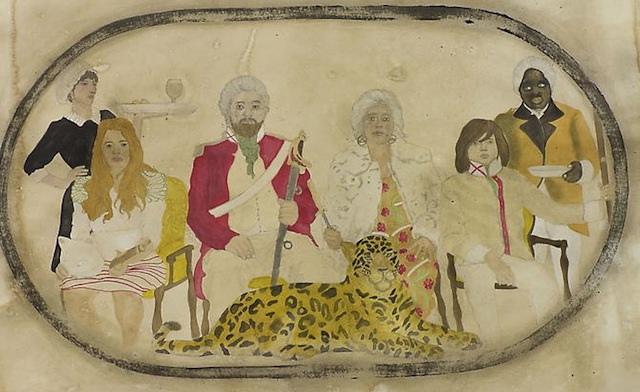(Re)Inventing the past

While in Denver for a summer wedding, I had the opportunity to visit the Museum of Contemporary Art (MCA), a smallish, spare, but amazing space in the city’s downtown. Though contemporary art is thought of by many as bizarre, lacking in subtlety, garish or shocking for the sake of being garish and shocking, the contemporary section of any art museum tends to be my favorite. Is it because I’m a postmodernist who critiques, but ultimately embraces the power of play, metaplay, and remixing? Is it because I’m the kind of mucky muck who throws around words like “postmodern?” Who’s to say? It’s not that I’m against the more classic works, no, not at all! Mostly, I’m just not very moved by the “crusty old portraiture of important white dudes and the wives who married them” displays in your typical art museum. Funny then that the work that most struck and inspired me at the MCA was a collection of what, at first glance, seems to be exactly that kind of historical portraiture.
So, yes, when I paid my (actually pretty cheap) entrance fee and turned the corner to see Frohawk Two Feathers’ first room of pieces I wasn’t too sure what I had gotten myself into. Upon further inspection, I found a number of portraits and maps each painted and weathered in a style that suggests they were artifacts from a distant past. The portraits featured royals, generals, early settlers from a colonial history dreamed up and intricately fleshed out by Two Feathers’ research and imagination. Instead of your typical placards simply offering title, medium, and artist information, the signs also presented a healthy helping of facts about the figures and spaces depicted in the paintings. Moving from piece to piece, one gathers patchwork pieces of the larger story of the “Frenglish Empire” and its expansion to North American territory. Somewhat based upon historical accounts of figures like Cromwell and Napoleon Bonaparte, Two Feathers’ narrative is built from many familiar plot points. The pictures and their accompanying (his)stories ultimately play with, question, and critique the histories we know and cling to while additionally parsing issues of domination, colonialism, wealth, and representation.
Frohawk Two Feathers’ commentary on authenticity and archives as it forms in this production of false-ish history is complex, revisionary, and playful. Depictions of these people — people important enough to be enunciated through art and whose renderings are then worthy of keeping as historical artifact — are refreshingly colorful, tattooed, and often outfitted in period costume with nods to modern day urban and ethnically marked looks. Men and women sport bandanas and teardrop tats on their brown (Native, Spanish, African, mixed) bodies while holding the poses of the noble people we overwhelmingly have encountered as white in our historical instruction. In creating these characters, he imagines a history in which people of color make the rules, set the fashions, mark the territory, and though it is no less war-mongering than the stories we already know, the insertion of color in this way not only creates a picture of pride and power where we rarely see one (as in a museum setting) but also critiques the level to which white history has been constructed as Truth.

The artist’s maps and sculptural artifacts such as drums and animal skins painted from the perspective of native peoples further complicate and renegotiate issues of constructedness, authenticity, and point of view. Representations of important battles might be framed with images of the gape-jawed gods that protect or rule a community — sea monsters ruling the edges of a map’s open water. Little white male figures looking like tiny George Washingtons are drawn cowering in fear or stupified in the face of more powerful native warriors on steady steeds. At times I felt Two Feathers’ message could devolve into a simple flipping of power — one that luxuriates in a revenge fantasy, or too simply plays with hot-button postcolonial concerns. However, though I can’t explain it precisely, the feel of the entire show at the MCA never dipped that low. The tiny details in the tattoo and map ink and in the remaking, the fashioning of objects, successfully elevated the work into an endlessly thought-provoking and disruptive artistic plane.
Since I know we can’t all attend weddings in Colorado, I suggest you check this artist out in whatever way you can. Two Feathers’ various multi-media pieces tug at the structures we so often take for granted as real or normative or invisible. His work reminds us that the way we map and the things we archive define peoples and cultures and thus the cartographers and archivists hold a special power. Through his invention of the past he demonstrates that history has always been storytelling and making, and history has always been and continues to be invented.
—
Ana Holguin writes PopHeart for The Idler.
Comments
2 Responses to “(Re)Inventing the past”Trackbacks
Check out what others are saying...-
[…] HERE for the complete […]
I couldn’t have said it better myself. I have often tried to explain to my friends and others the meaning of my sons work. Read your article and Voila! exactly what I have meant but could not express. Thanks.
Virgie, Mother of the Artist Frohawk Two Feathers